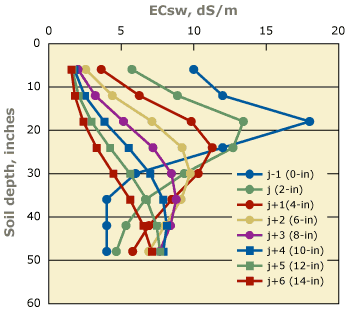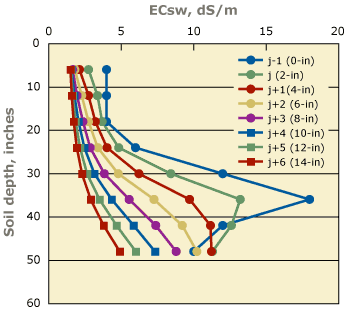- Home
- Learn about salinity
- Get to know your site
- Design a landscape
- Solve a problem
- Other information
Salinity Management Guide
Managing soil salinity
Management option: Reclamation leaching

Figure 12. Reclamation leaching of saline soil that has a high-salt zone at shallow depth; water applied over time in successive increments of 2 acre-inches per acre.
Reclamation leaching is the application of excess water, usually by sprinklers, until the soil salts are leached out of the intended root zone. In some instances, the land being developed for a landscape is already salt-affected and requires reclamation leaching before landscape plantings can be established. In some other instances, the root zone within an already-developed landscape has become too saline for the existing plants, necessitating "repair" — either by increasing LF or by implementing a program of reclamation leaching.
How much water should be applied for reclamation (i.e., when to cease applying water) can be ascertained by monitoring the salinity of the soil profile while leaching the soil to the desired salinity level. The position of salt in the soil profile determines how much leaching will be required.
Figure 12 depicts the changes in salinity that occur when a soil with high salt presence near the surface is leached with water of EC 1.5 dS/m. The salt "bulge" at relatively shallow soil depths is slowly displaced downward over time as water is applied — in this case, at a rate of 2 acre-inches per acre. In most cases, eventually, as more water is applied, the soil salinity can be lowered to levels that are safe for plants.

Figure 13. Reclamation leaching of saline soil that has a high-salt zone relatively deep in the profile; water applied over time in successive increments of 2 acre-inches per acre.
Figure 13 depicts a similar soil profile, but with the salt bulge relatively deep. As for the aforementioned shallow-salt example, when leached with water of EC 1.5 dS/m, the soil salinity decreases markedly at depth as more and more water is applied. It takes less water to reclaim a soil that has a salt "bulge" relatively deep in the profile than it does for a soil that has its high-salt zone near the surface.
| « Previous page | Next page » |